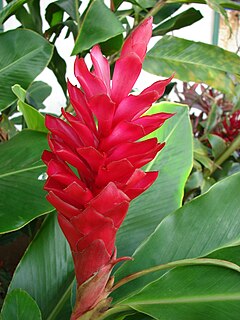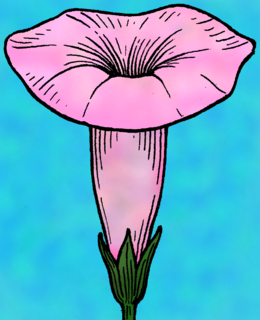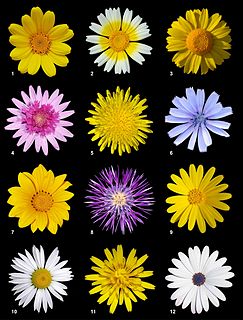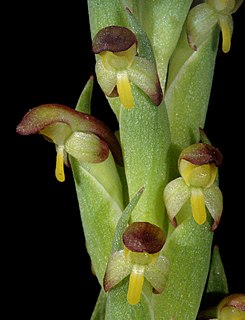
Asparagales is an order of plants in modern classification systems such as the Angiosperm Phylogeny Group (APG) and the Angiosperm Phylogeny Web. The order takes its name from the type family Asparagaceae and is placed in the monocots amongst the lilioid monocots. The order has only recently been recognized in classification systems. It was first put forward by Huber in 1977 and later taken up in the Dahlgren system of 1985 and then the APG in 1998, 2003 and 2009. Before this, many of its families were assigned to the old order Liliales, a very large order containing almost all monocots with colorful tepals and lacking starch in their endosperm. DNA sequence analysis indicated that many of the taxa previously included in Liliales should actually be redistributed over three orders, Liliales, Asparagales, and Dioscoreales. The boundaries of the Asparagales and of its families have undergone a series of changes in recent years; future research may lead to further changes and ultimately greater stability. In the APG circumscription, Asparagales is the largest order of monocots with 14 families, 1,122 genera, and about 36,000 species.

The Dioscoreales are an order of monocotyledonous flowering plants in modern classification systems, such as the Angiosperm Phylogeny Group and the Angiosperm Phylogeny Web. Within the monocots Dioscoreales are grouped in the lilioid monocots where they are in a sister group relationship with the Pandanales. Of necessity the Dioscoreales contain the family Dioscoreaceae which includes the yam (Dioscorea) that is used as an important food source in many regions around the globe. Older systems tended to place all lilioid monocots with reticulate veined leaves in Dioscoreales. As currently circumscribed by phylogenetic analysis using combined morphology and molecular methods, Dioscreales contains many reticulate veined vines in Dioscoraceae, it also includes the myco-heterotrophic Burmanniaceae and the autotrophic Nartheciaceae. The order consists of three families, 22 genera and about 850 species.

In biology, taxonomy is the scientific study of naming, defining (circumscribing) and classifying groups of biological organisms based on shared characteristics. Organisms are grouped into taxa and these groups are given a taxonomic rank; groups of a given rank can be aggregated to form a more inclusive group of higher rank, thus creating a taxonomic hierarchy. The principal ranks in modern use are domain, kingdom, phylum, class, order, family, genus, and species. The Swedish botanist Carl Linnaeus is regarded as the founder of the current system of taxonomy, as he developed a ranked system known as Linnaean taxonomy for categorizing organisms and binominal nomenclature for naming organisms.

The Zingiberales are flowering plants forming one of four orders in the commelinids clade of monocots, together with its sister order, Commelinales. The order includes 68 genera and 2,600 species. Zingiberales are a unique though morphologically diverse order that has been widely recognised as such over a long period of time. They are usually large herbaceous plants with rhizomatous root systems and lacking an aerial stem except when flowering. Flowers are usually large and showy, and the stamens are often modified (staminodes) to also form colourful petal-like structures that attract pollinators.

The dicotyledons, also known as dicots, are one of the two groups into which all the flowering plants or angiosperms were formerly divided. The name refers to one of the typical characteristics of the group, namely that the seed has two embryonic leaves or cotyledons. There are around 200,000 species within this group. The other group of flowering plants were called monocotyledons or monocots, typically having one cotyledon. Historically, these two groups formed the two divisions of the flowering plants.

Monocotyledons, commonly referred to as monocots, are grass and grass-like flowering plants (angiosperms), the seeds of which typically contain only one embryonic leaf, or cotyledon. They constitute one of the major groups into which the flowering plants have traditionally been divided, the rest of the flowering plants having two cotyledons and therefore classified as dicotyledons, or dicots.

The order Pinales in the division Pinophyta, class Pinopsida, comprises all the extant conifers. The distinguishing characteristic is the reproductive structure known as a cone produced by all Pinales. All of the extant conifers, such as cedar, celery-pine, cypress, fir, juniper, larch, pine, redwood, spruce, and yew, are included here. Some fossil conifers, however, belong to other distinct orders within the division Pinophyta.

Ranunculales is an order of flowering plants. Of necessity it contains the family Ranunculaceae, the buttercup family, because the name of the order is based on the name of a genus in that family. Ranunculales belongs to a paraphyletic group known as the basal eudicots. It is the most basal clade in this group; in other words, it is sister to the remaining eudicots. Widely known members include poppies, barberries, and buttercups.

George Bentham was an English botanist, described by the weed botanist Duane Isely as "the premier systematic botanist of the nineteenth century". Born into a distinguished family, he initially studied law, but had a fascination with botany from an early age, which he soon pursued, becoming president of the Linnaean Society in 1861, and a fellow of the Royal Society in 1862. He was the author of a number of important botanical works, particularly flora. He is best known for his taxonomic classification of plants in collaboration with Joseph Dalton Hooker, his Genera Plantarum (1862–1883). He died in London in 1884.

Pandanales, the pandans or screw-pines, is an order of flowering plants placed in the monocot clade in the Angiosperm Phylogeny Group and Angiosperm Phylogeny Web systems. Within the monocots Pandanales are grouped in the lilioid monocots where they are in a sister group relationship with the Dioscoreales. Historically the order has consisted of a number of different families in different systems but modern classification of the order is based primarily on molecular phylogenetics despite diverse morphology which previously placed many of the families in other groupings based on apparent similarity. Members of the order have a subtropical distribution and includes trees, shrubs, and vines as well as herbaceous plants. The order consists of 5 families, 36 genera and about 1,610 species.

(Sympetaly directs here)

A taxonomic system, the Bentham & Hooker system for seed plants, was published in Bentham and Hooker's Genera plantarum ad exemplaria imprimis in herbariis kewensibus servata definita in three volumes between 1862 and 1883.

Lilianae is a botanical name for a superorder of flowering plants. Such a superorder of necessity includes the type family Liliaceae. Terminations at the rank of superorder are not standardized by the International Code of Nomenclature for algae, fungi, and plants (ICN), although the suffix -anae has been proposed.

Gamopetalae is an artificial historical group used in the identification of plants based on Bentham and Hooker's classification system.

Inferae is an artificial group used in the identification of plants based on Bentham and Hooker's classification. Bentham and Hooker published an excellent classification in three volumes in between 1862 and 1883. As a natural system of classification, it does not show evolutionary relationship between plants but still is a useful and popular system of classification based on a dichotomous key especially for the flowering plant groups (angiosperms). It is the most popular system of classification based on key characteristics enabling taxonomic students to quickly identify plant groups based only on physical characteristics. However, it is not a scientific group and is used for identification purposes only based on similar plant characteristics. Under the system Inferae are a group of plants based on an artificial and non scientific series. The group Inferae are Gamopetalae and dicotyledons. The group comprises;

Bicarpellatae is an artificial group used in the identification of plants based on Bentham and Hooker's classification system. George Bentham and Joseph Dalton Hooker published an excellent classification in three volumes in between 1862 and 1883. As a natural system of classification, it does not show evolutionary relationship between plants but still is a useful and popular system of classification based on a dichotomous key especially for the flowering plant groups (angiosperms). It is the most popular system of classification based on key characteristics enabling taxonomic students to quickly identify plant groups based only on physical characteristics. However, it is not a scientific group and is used for identification purposes only based on similar plant characteristics. Under the system Bicarpellatae are a group of plants based on an artificial and non scientific series. The group Bicarpellatea are Gamopetalae and dicotyledons. The group comprises;

Monochlamydae is an artificial taxonomic group used in the identification of plants. It was largely abandoned by taxonomists in the 19th century, but has been often used since. Bentham and Hooker's classification, published in 1880, used this grouping, but stated that it was neither natural nor well defined, and that De Candolle's system was superior. Under Engler and Prantl's revision of 1931, the group Monochlamydeae was completely abandoned.

The Amaryllidaceae are a family of herbaceous, mainly perennial and bulbous flowering plants in the monocot order Asparagales. The family takes its name from the genus Amaryllis and is commonly known as the amaryllis family. The leaves are usually linear, and the flowers are usually bisexual and symmetrical, arranged in umbels on the stem. The petals and sepals are undifferentiated as tepals, which may be fused at the base into a floral tube. Some also display a corona. Allyl sulfide compounds produce the characteristic odour of the onion subfamily (Allioideae).

Disinae is a subtribe of orchids that has been differently defined and placed in the two classification systems that are currently in use for orchids. Genera Orchidacearum, which is currently the definitive work on orchid taxonomy, delimits Disinae as consisting of two closely related genera, Disa and Schizodium, and it places Disinae in the mostly African tribe Diseae, along with four other subtribes: Brownleeinae, Huttonaeinae, Coryciinae, and Satyriinae. In the classification for orchids that was published by Chase et alii in 2015, Schizodium was placed in synonymy under Disa, while Pachites and Huttonaea were transferred to Disinae. In Genera Orchidacearum, Pachites and Satyrium form the subtribe Satyriinae, and Huttonaea is the sole genus in the subtribe Huttonaeinae. The transfer of Pachites and Huttonaea to Disinae by Chase et alii (2015) was done with considerable doubt, and was based upon uncertainty about the relationships of these two genera. In 2009, a molecular phylogenetic study found only weak statistical support for a sister relationship between Huttonaea and Disa.

Coronariae is a term used historically to refer to a group of flowering plants, generally including the lilies (Liliaceae), and later replaced by the order Liliales. First used in the 17th century by John Ray, it referred to flowers used to insert in garlands. Coronariae soon came to be associated with Liliaceae in the Linnaean system. The term was abandoned at the end of the 19th century, being replaced with Liliiflorae and then Liliales.




















